|
| |
1st Image of Whale From Space
The image on the right is the first ever whale image
from space, captured by IKONOS in a January 8, 2000 image of Shamu's tank at
Sea Wo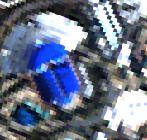 rld, San Diego.
The image is pixilated at the raw image resolution - 4m. The whale is
a 3-pixel smudge in the right tank. IKONOS and QuickBird are the first
commercial satellites to have enough resolution to detect individual whales. rld, San Diego.
The image is pixilated at the raw image resolution - 4m. The whale is
a 3-pixel smudge in the right tank. IKONOS and QuickBird are the first
commercial satellites to have enough resolution to detect individual whales.
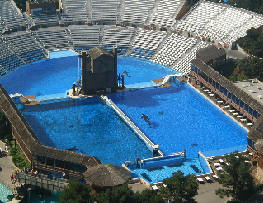 The image on
the left shows how Sea World visitors see Shamu's tank from the SkyTower
next door. We took this photo
on October 14, 2001, at the instant when an Orca was at
approximately the same place in the right tank as in the January 2000
space image. These photos were part of a study on detection of whales with satellite
imagery for animal census in remote areas of the world.
Humpbacks were detected in an IKONOS satellite image of the waters off
Maui. See my publications list for more information.
Also see discussions of this work in a NASA Earth Observatory story
and in
Woody Turner et al.
The image on
the left shows how Sea World visitors see Shamu's tank from the SkyTower
next door. We took this photo
on October 14, 2001, at the instant when an Orca was at
approximately the same place in the right tank as in the January 2000
space image. These photos were part of a study on detection of whales with satellite
imagery for animal census in remote areas of the world.
Humpbacks were detected in an IKONOS satellite image of the waters off
Maui. See my publications list for more information.
Also see discussions of this work in a NASA Earth Observatory story
and in
Woody Turner et al.
|
Coral Reefs
Signal processing makes sun glint
disappear
and
ocean bottom features
clearer. A special
algorithm (US patent
6304664) is used to remove
sunlight reflec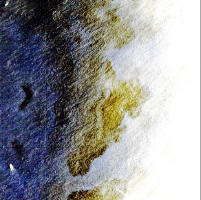 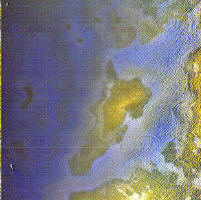 tions from the ocean surface so
that features beneath the surface are more readily
visible. In above
example the image on the left is the original with bright sun glint
masking portion ofthe area. On the right is the same image after
glint removal. Note: water wake of small boat (lower left
corner) is also removed. tions from the ocean surface so
that features beneath the surface are more readily
visible. In above
example the image on the left is the original with bright sun glint
masking portion ofthe area. On the right is the same image after
glint removal. Note: water wake of small boat (lower left
corner) is also removed.
|
Bathymetry
A sequence of two or more images of ocean waves can be
processed into water depth maps. This method was first
demonstrated with satellite images in 2005.
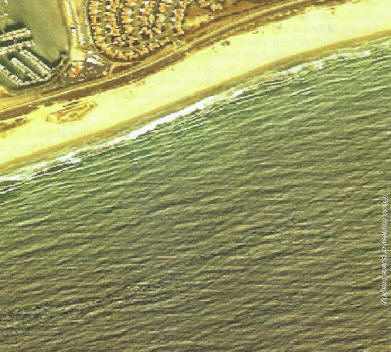 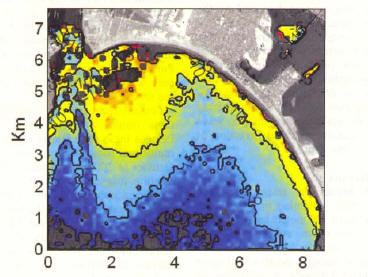 Left: IKONOS image of shoaling waves off Silver Stands Beach, San Diego.
This is the site used of the 2005 satellite bathymetry test.
Right: the satellite bathymetry overlay, color coded from shallow (red)
to deep (blue). The inlet into San Diego harbor in in center and
upper left. Silver Strands Beach is on the peninsula on the right.
See
Sea Technology paper and
Conference paper Left: IKONOS image of shoaling waves off Silver Stands Beach, San Diego.
This is the site used of the 2005 satellite bathymetry test.
Right: the satellite bathymetry overlay, color coded from shallow (red)
to deep (blue). The inlet into San Diego harbor in in center and
upper left. Silver Strands Beach is on the peninsula on the right.
See
Sea Technology paper and
Conference paper
|
Humpback
An ordinary digital camera image was
processed to reveal mother and calf humpbacks. The photo on the left was taken from a Pacific Whale Foundation whale
watch boat off Maui. On the right is the same image, after special
processing, shows mother and calf under the surface. The
algorithm is similar to the one used on coral reefs, but modified
to work with an ordinary digital camera JPEG image file.
A similar algorithm was used to detect humpback whales from space with
the IKONOS satellite.
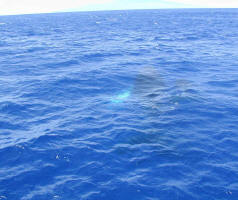 . . 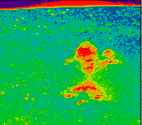
|
|
Papers
You can download most of my papers from
my electronic-library.
|
|
|
© 2005
R. Abileah
|